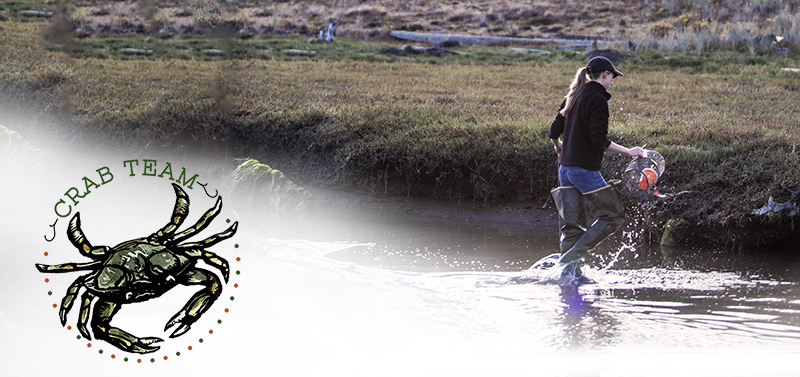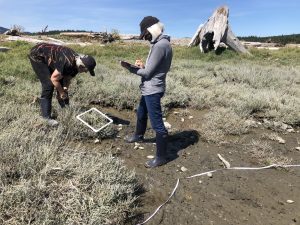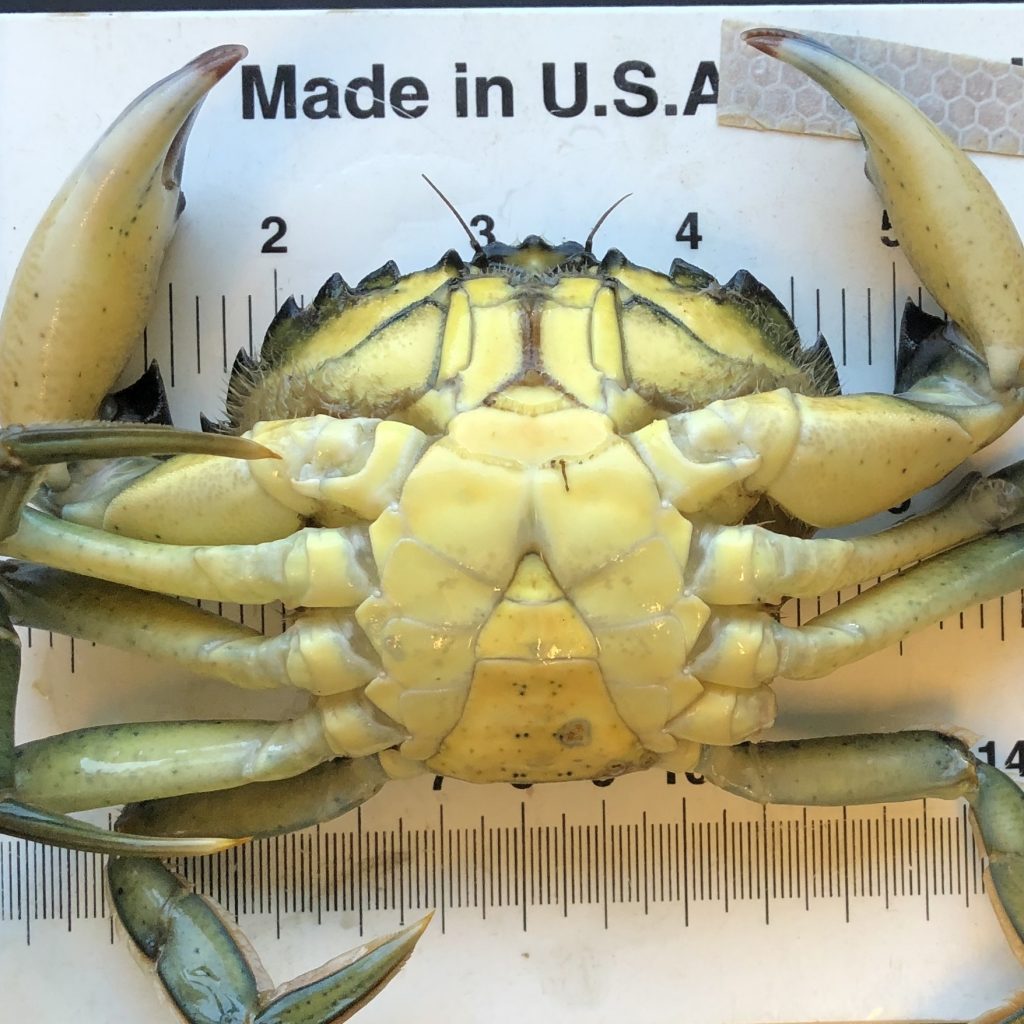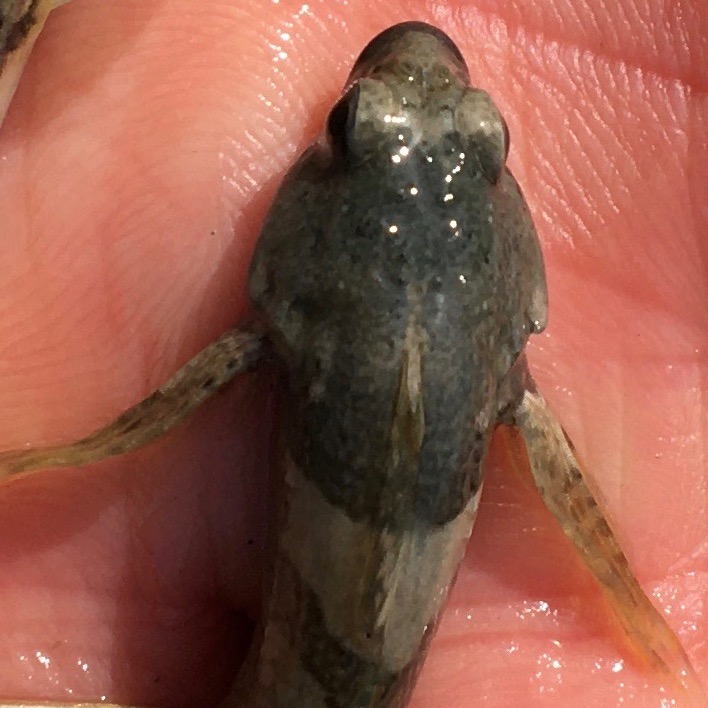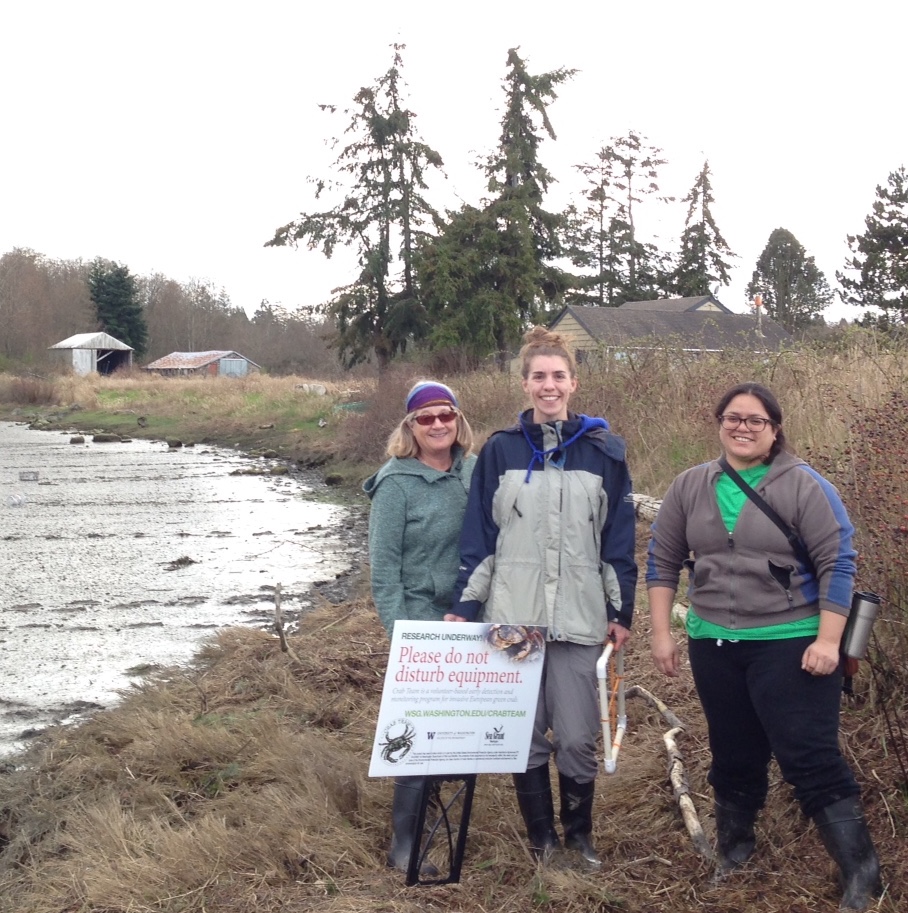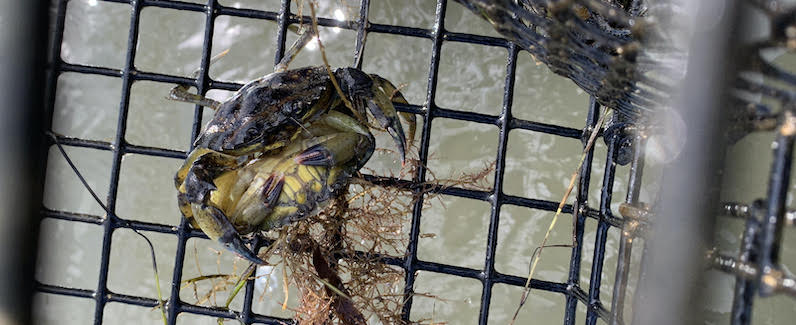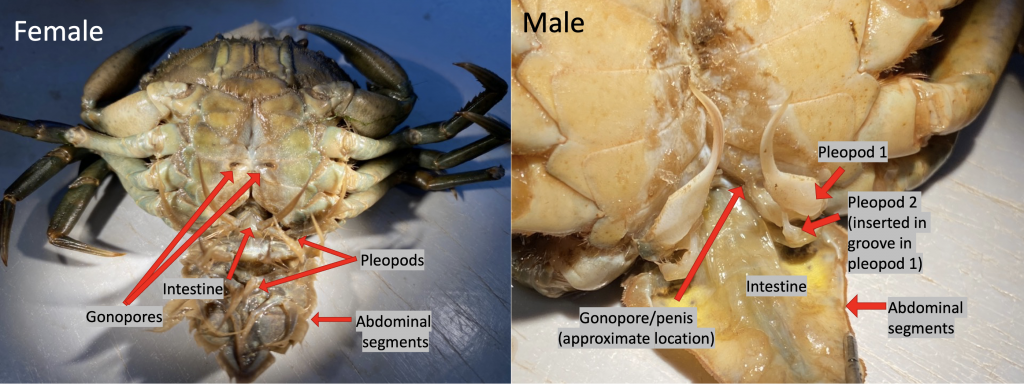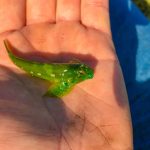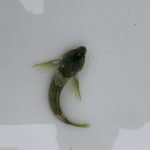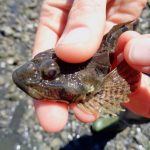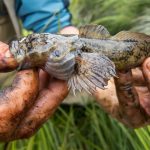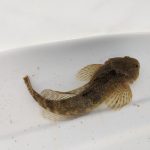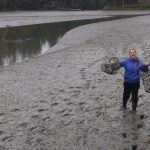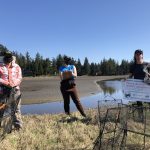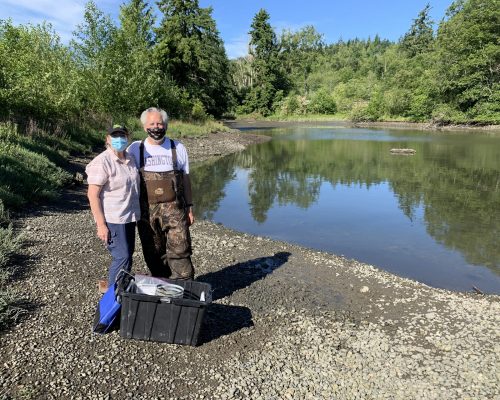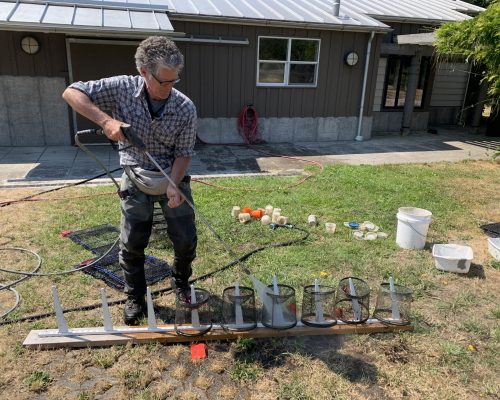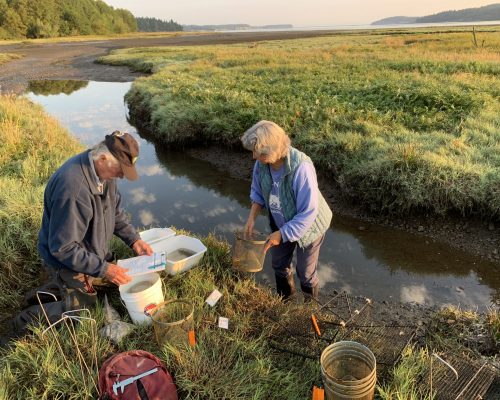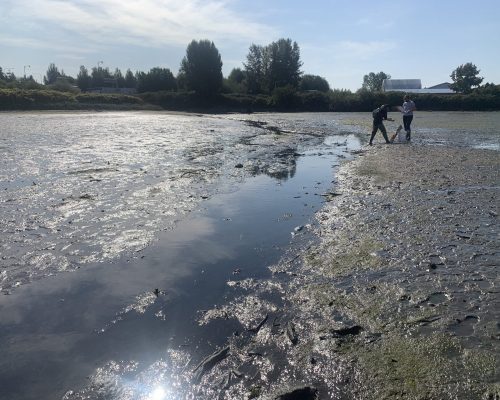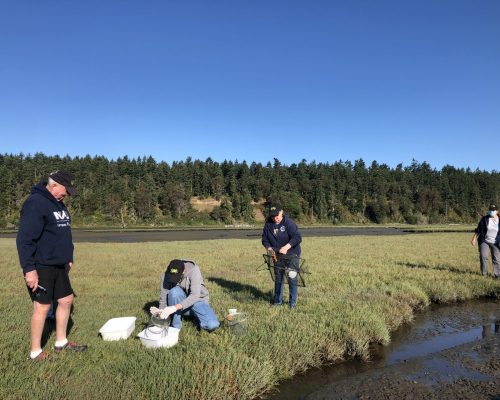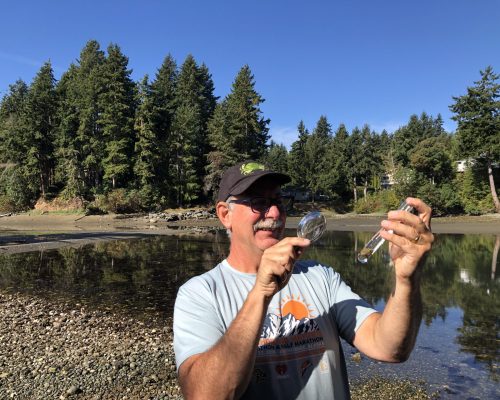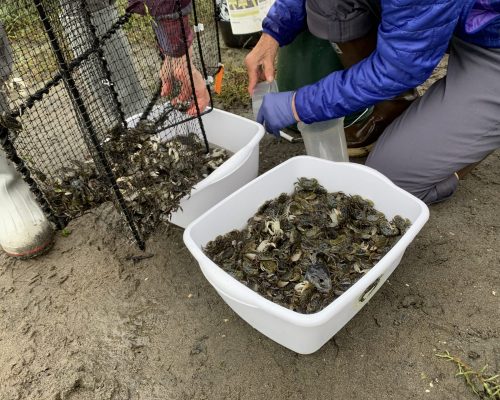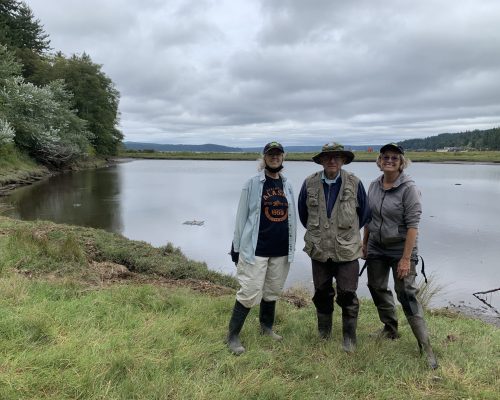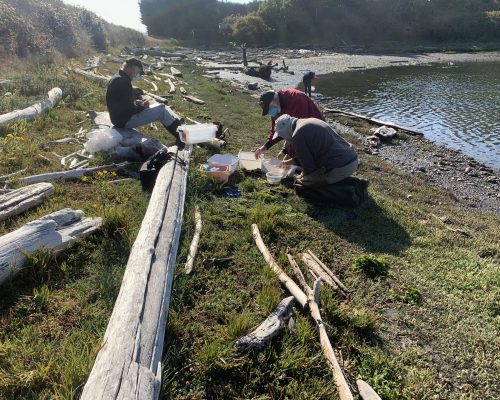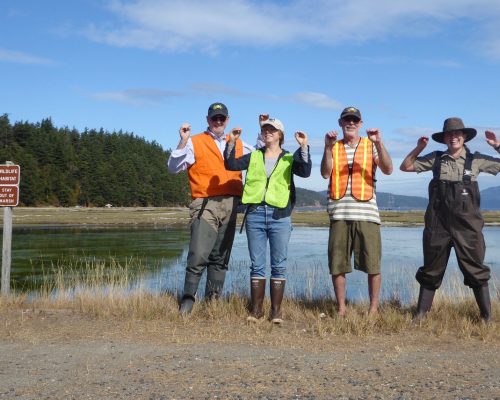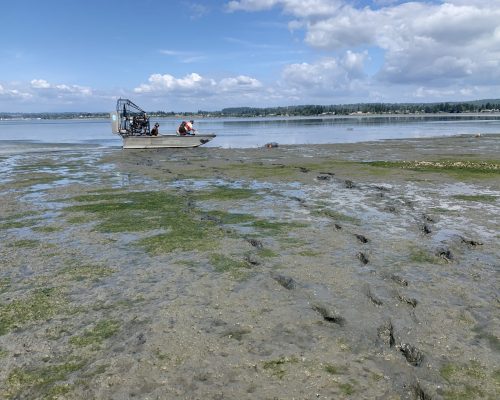Five Years Later
November, 2021
It’s been a little over five years since the first capture of invasive European green crab along Washington’s inland shorelines. As we look back at how much we’ve learned since this capture, we are so grateful to the hundreds of volunteers and partner staff who have made this detection and many more possible over the years. Unfortunately, green crab detections have become less rare since green crab were first detected at Westcott Bay in 2016 by Crab Team volunteers. But just as the number of captures has grown, so has the community of committed crabbers, whether volunteers, managers, shellfish growers, or just beach goers who commit their time to protecting shorelines from invasive green crabs. Crab Team launched as an early detection and monitoring effort, and even as we work hard to fight the invasion, the data collected during monthly trapping surveys becomes ever more valuable.
And so we dedicate this issue in gratitude to the volunteers who have been with us since August 2015, the very first month of Crab Team trapping. That’s right, many of those brave folks who took the plunge into the mud with us from the outset are still out there trapping. That’s 38 surveys and 216 trap sets for those doing the math. The consistency and experience they bring to sampling is so incredibly valuable to a dataset like Crab Team, and we don’t take for granted that doing the hard work of science can, at times, feel a bit repetitive, but we are astounded at the curiosity, creativity, spirit and dedication they have continued to bring all these years.
month of Crab Team trapping. That’s right, many of those brave folks who took the plunge into the mud with us from the outset are still out there trapping. That’s 38 surveys and 216 trap sets for those doing the math. The consistency and experience they bring to sampling is so incredibly valuable to a dataset like Crab Team, and we don’t take for granted that doing the hard work of science can, at times, feel a bit repetitive, but we are astounded at the curiosity, creativity, spirit and dedication they have continued to bring all these years.
In this year’s fall newsletter edition, we’ve put together a cornucopia of feature articles on hot topics, including how European green crabs reproduce, a deep dive into our scads of sculpins, and a spotlight on the Crab Team site at Drayton Harbor. Happy reading!
All our pinchy best,
Crab Team HQ
Let’s talk about sex
It’s no secret that biologists think about sex a lot. I mean, a lot, a lot. After all, reproduction is a cornerstone of the theory of Natural Selection (Williams 1966). Organisms that survive and reproduce perpetuate their genes and those that don’t, don’t. For more than 99.99% of eukaryotes, this reproduction requires sex so it’s no wonder biologists have sex on the brain. In fact, fields like Organismal Biology and Animal Behavior truly boil down to the study of the four F’s: feeding, fighting, fleeing, and – you guessed it – fornicating (Garvey et al. 2020). Invasion Biology is no different and much attention is focused on the topic because, not surprisingly, invasive species tend to be very good at reproducing.
Green crabs are of course no exception, and biologists have long noted the proficiency with which the species can reproduce in new environments. The specifics of how green crabs do the deed have been well-documented over the past 55 years through spicy and voyeuristically titled works like “An observed act of copulation in the shore crab, Carcinus maenas (L.)” (Cheung 1966*), “Multiple matings and sperm competition” (Becker & Bauer 2020), and “Mating behavior of the green shore crab Carcinus maenas” (Berrill & Arsenault 1982). These studies lay out the chemistry, anatomy, and behavior of green crab reproduction in fascinating detail.
What’s going on under the hood?
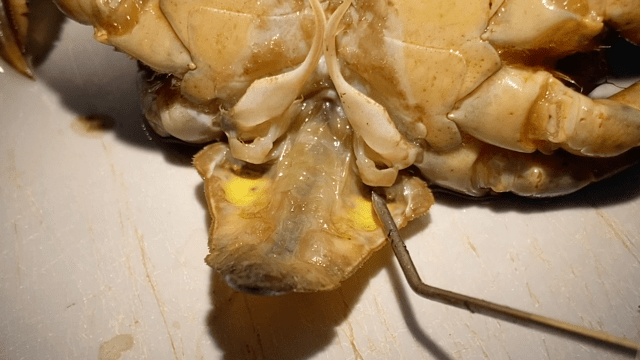
A look inside a male green crab’s abdominal flap. Notice how the 2 pairs of appendages work together, with the bottom pair acting as plungers for the top pair.
First, an anatomy lesson. We’ve previously discussed how male and female crabs can be distinguished by the shape of their abdomen, but that’s only part of the story; pulling back the flap reveals the more intimate details of the reproductive system. Male green crabs use two pairs of specialized reproductive appendages for mating (Spalding 1942). These appendages, nestled delicately beneath the hard abdominal flap, are essentially modified legs. The first pair are long and hollow, like the barrel of a hypodermic needle, while the second pair are smaller and act like plungers. Together these appendages form twin gonopods and act like a sort of double barrel injection system. One would not be faulted for thinking of these as penises, but actually the penises (yes, plural) are just small, fleshy nubs at the base of each gonopod that load this injection system with spermatophores. Each spermatophore is a cocktail of sperm, fluids, and a sticky chitinous substance that acts to hold everything in place once embedded in the female.
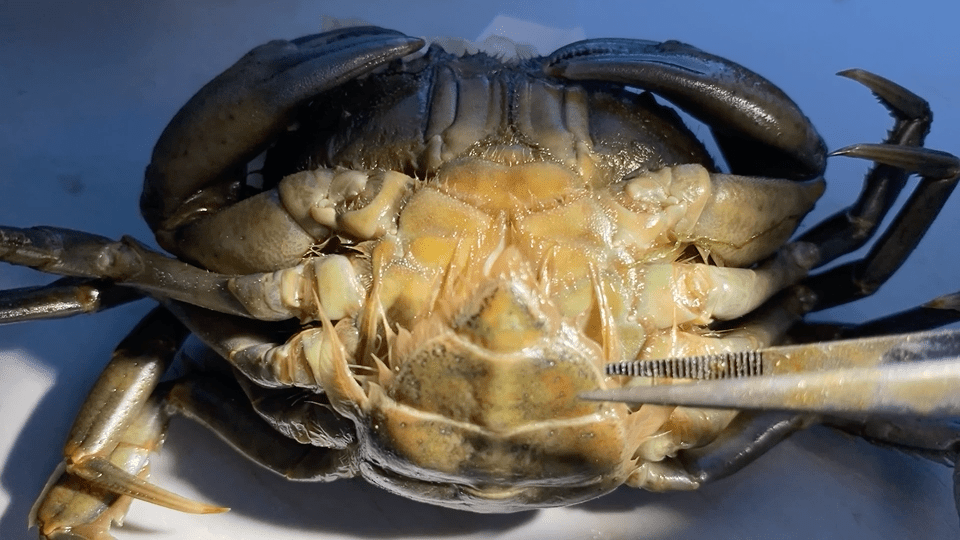
Inside the abdominal flap of a female green crab. Notice the two distinct gonopores and multiple feathery appendages.
The female reproductive anatomy, by contrast, is somewhat cryptic. Beneath the broad abdominal flap are layers of feathery appendages – again, modified legs – that will eventually provide an attachment point for extruded eggs. The only reproductive organs visible are the large paired gonopores that reveal the opening to the two vaginas (Spalding 1942). Internally though, things are much more interesting, with each vagina opening up into an enlarged chamber called the spermatheca, where the spermatophores will eventually be deposited. Female crabs can store sperm for a year or more within the spermatheca and may produce multiple clutches of eggs from a single mating.
Birds do it, bees do it…
Mating in green crabs is complicated. After all, an armored shell is great for defense but it makes sex awkward, if not impossible. Although some crab species can mate ‘hard-shelled’, green crabs cannot. Females must be in a newly-molted, soft condition in order to copulate. Thus, timing is everything. Females attract would-be suitors by exuding chemical attractants, called pheromones, in their urine (Eales 1973*), as their molt approaches. The smell of a ripe female can send males into a frenzy and competition often gets violent, frequently resulting in injury. Larger, older males are more aggressive than their smaller, younger counterparts, and tend to win these contests and drive away rival suitors. Interestingly, females also favor bigger males when given a choice (Sneddon et al. 2003*); receptive females may release more pheromones when a suitable male is present and frequently initiate courtship behaviors with a desired suitor. In these situations, the female may fall backward exposing their abdomen while performing an abdominal flapping motion for a minute or more, before sidling up beneath the male.
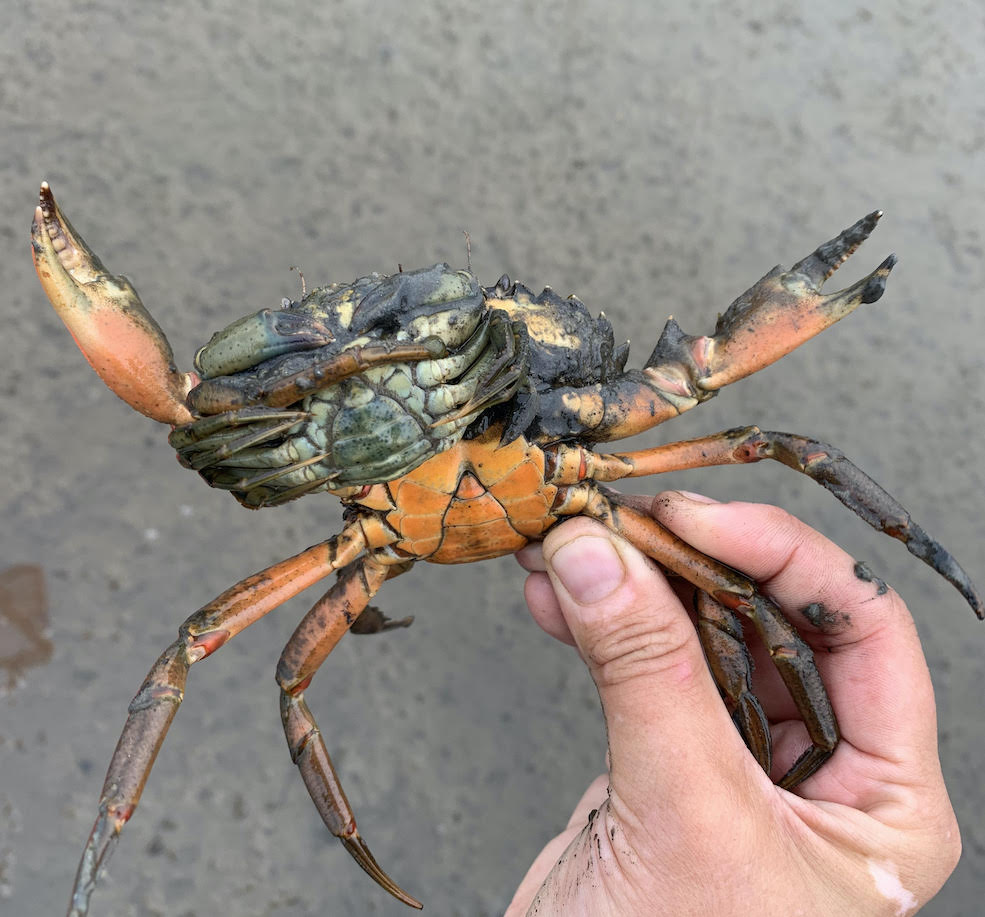
Male European green crab grasps the female in the pre-copulatory embrace. This behavior may continue for up to two weeks. Photo courtesy of Chelsey Buffington, Washington Department of Fish and Wildlife
Once the male grasps the female in the pre-copulatory embrace, they will remain that way for up to two weeks. In this crustacean equivalent of ‘spooning’, the male carries the female everywhere, using his walking legs to hold her close, while fending off rival males with his claws (note: although neither crab seems very interested in feeding, we still occasionally find pairs in traps, likely driven more by instinct than hunger). When the female signals her molt is imminent, the male releases her briefly, only to grasp her once again in the copulatory embrace. With abdomens folded open, and male and female pressed close together “face to face”**, the pair begins mating. Now upside down, the female holds herself in place with the tips of her walking legs. Whereas for many creatures, the actual act of sex is a fleeting sprint, crab sex is a marathon. On average, green crab sex lasts more than 2.5 days (Berrill & Arsenault 1982)! Typically, the couple find a secluded spot during this time to avoid disturbance, which is critical not only to avoid interruption but to protect the female; with her shell not fully hardened, she could easily be damaged by another male or a predator. In fact, once mating is completed, the male will continue to hold the female in a post-copulatory embrace to provide additional protection in a behavior called mate guarding (Christy 1987). Eventually the male releases the female and the two go their separate ways.
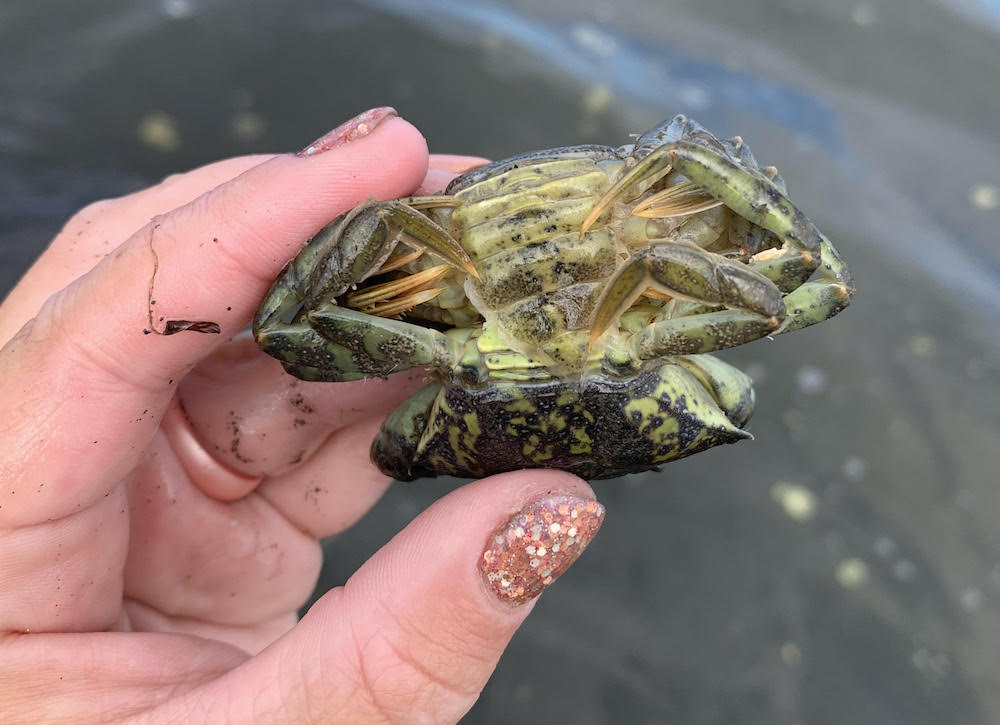
With abdominal flaps open, male and female green crabs mate face to face, often for over 2.5 days. Photo courtesy of Chelsey Buffington, Washington Department of Fish and Wildlife
For biologists, mating systems like this are extremely interesting for evaluating evolutionary questions. For example, one might ask why mate guarding occurs; from a male crab’s point of view wouldn’t it make more sense to mate with as many females as possible rather than investing precious time on a single encounter? That’s where sperm competition theory comes in (Becker & Bauer 2020). If a male releases a female too early, then she will most likely mate again, and male copulatory systems are well-adapted to thwart rival sperm. For example, bristles on the tips of the gonopods, fashioned like a bottle brush, may remove a previous male’s sperm. The shape of the gonopod, which is strongly curved (Clark et al. 2001), also ensures that the last male’s ‘deposit’ is placed more advantageously to ensure fertilization, in a process aptly called, “last male precedence” (Becker & Bauer 2020). And then there’s the spermatophore itself; the chitinous adhesive that holds the sperm in place can form a plug that seals off and segregates sperm from previous males (Beninger & Larocque 1998). Less is known about how female green crab influence this competition, although research in other species, including Dungeness crab (Jensen et al. 1996), suggests that females may ultimately determine which males are successful.
The truth is that we’re still learning about the interesting sex lives of green crabs. While these new discoveries can be fascinating in their own right, understanding the details of how, when, and where green crabs find mates and reproduce can be incredibly helpful for developing successful approaches for management. For instance, researchers are already hard at work developing artificial sex pheromones that may someday help us attract frisky crabs before they mate. Every new discovery gives us biologists more to think about and could give managers more tools to control invasions.
-P. Sean McDonald
*While we try to link you directly to the research we reference, some of the studies cited in this article are not open access. If you have any questions about any of the works cited here, please feel free to reach out to crabteam@uw.edu.
**Interestingly, “face to face” mating is somewhat rare in the animal kingdom, particularly outside of mammals like the great apes and cetaceans (i.e., dolphins and whales). In fact, it’s so rare in invertebrates that observations of the behavior in Pacific striped octopus were said to have “stunned scientists”.
Species Name: Cottus asper
Common Name: Prickly sculpin
Species Code: COAS
Geographic Range: Southcentral Alaska to southern California
Size: up to about 7.5”
Prickly, Tidepool, Padded and Prongs – Crab Team’s Cadre of Cottidae
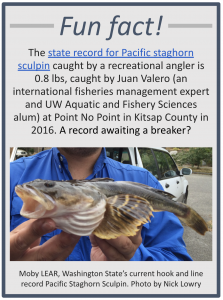 When it comes to Crab Team sculpins, LEAR is king – Leptocottus armatus that is, the staghorn sculpin. Ah, staghorn… that tough-as-nails, live-a-while-out-of-water, eat-anything bullhead, who cruises up the beach with the tide and has wound up in traps at every regularly monitored Crab Team site. Crab Team members have now counted more than 20,000 staghorn sculpins! We know our LEAR. But staghorns are far from the only sculpin Crab Teamers encounter, and this year, we added a new species to the roster, so we figured it was time for a broader treatment of Crab Team’s bullheaded brethren.
When it comes to Crab Team sculpins, LEAR is king – Leptocottus armatus that is, the staghorn sculpin. Ah, staghorn… that tough-as-nails, live-a-while-out-of-water, eat-anything bullhead, who cruises up the beach with the tide and has wound up in traps at every regularly monitored Crab Team site. Crab Team members have now counted more than 20,000 staghorn sculpins! We know our LEAR. But staghorns are far from the only sculpin Crab Teamers encounter, and this year, we added a new species to the roster, so we figured it was time for a broader treatment of Crab Team’s bullheaded brethren.
Sculpins can be tough to identify, especially when we don’t often capture species other than staghorns. As we see more individuals of more species, however, we develop a better search image for the subtle differences. In fact, Crab Team staff are always improving our own search images as we discover new additions to the community of species who think our mackerel smells awesome (or wandered aimlessly into our traps). It’s thanks to all the excellent observations and photos Crab Teamers take that we can pick up on that richness in our samples. Now for some of that bullish-headed richness.
When we look at data from Crab Team sites in the Salish Sea, four sculpin species other than staghorn have been captured:
- Tidepool sculpin. Oligocottus maculosus (OLMA) come in second place to staghorn, with 164 (still 2 orders of magnitude fewer than LEAR) showing up at 11 of our 56 sites;
- Prickly sculpin. More Cottus asper (COAS), have been caught (190) than tidepool, but at fewer sites (7) with almost 90% of them coming from the North Duckabush site, and
- Great sculpin. A single Myoxocephalus polyacanthocephalus (MYPO), weighed down a Fukui trap on Shaw Island in 2020.
- Padded sculpin. In 2021, one new sculpin joined our list with a single Artedius fenestralis (ARFE), captured at each of two sites.
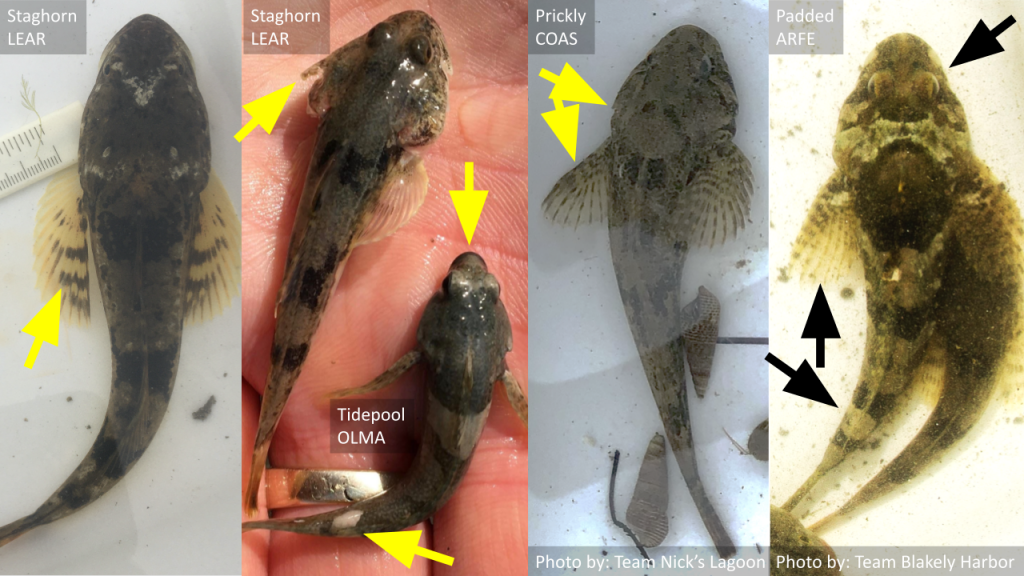
Crab Team’s sculpin to date (minus great sculpin – MYPO). Photos courtesy of the Nick’s Lagoon and Blakely Harbor Crab Teams and Jeff Adams
Oh OLMA
On our first Crab Team staff outing back in 2015, when we were trying to figure out how to put this whole enterprise together, tidepool sculpins were among the first critters we saw together. OLMA are little sculpin, maxing out around 3.5”, who can live in sheltered areas of the beach and get oxygen from the air if need be. They are very common but maybe less so in Crab Team traps because their diet is more buggy and less fishy, so maybe they shuffle into the traps more out of curiosity than the pull of mackerel.
A couple features that really help with identifying OLMA are their long, pinched nose, the thin bands on their pectoral fins and a bright white patch at the tail end of their dorsal fins. They also tend to like to curl their tail to the side when at rest, but that’s not an entirely unique behavioral feature among sculpins. Sharpnose sculpins look a lot like OLMA except with a light patch under their eyes and the first bright saddle patch being at the front of their dorsal fins.
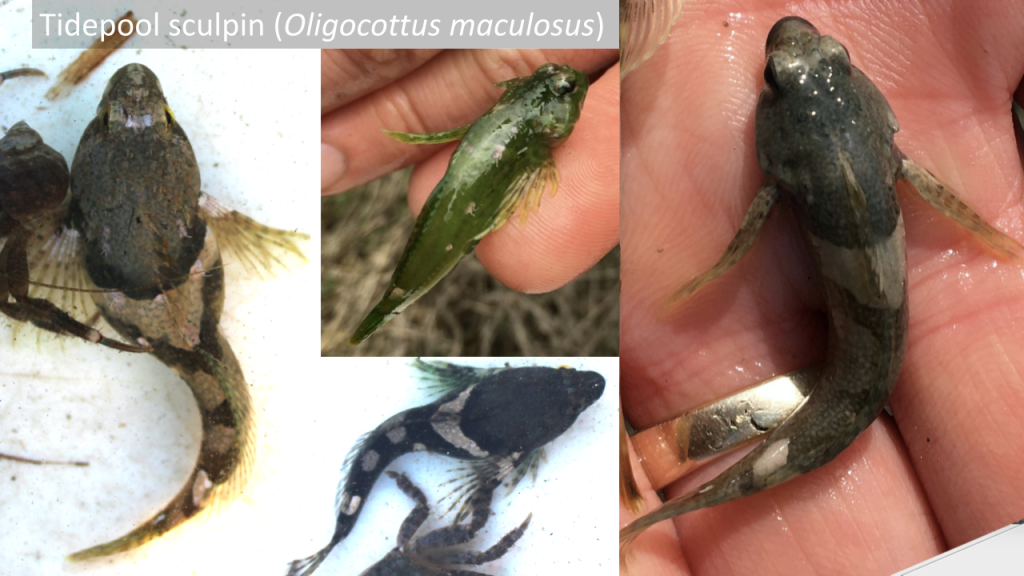
Tidepool sculpin (OLMA) showing their big eyes over a pinched nose, the bright white patch just before their tail and the range of color that is common among lots of sculpins. Photos courtesy of Jeff Adams
Catadromous COAS
The prickly sculpin is kind of like the staghorn of the stream, minus the stag horns. Their opercular spines are short, single points, which helps distinguish them from LEAR. They also have narrower color bands on their more circular (compared to LEAR’s oblong “lobe-shaped”) pectoral fins, but the two species do otherwise have a pretty similar overall body shape and broad head. Pricklies are primarily freshwater fish that are tolerant of, spend time in and even spawn in estuaries (catadromy), though they spawn in fresh water as well. They don’t get quite as large as staghorns but still reach almost 8”, about half the length of really large staghorns. In Crab Team’s monitoring, we tend to catch more prickly sculpin at sites with more freshwater influence. While doing an expanded trapping effort in the Harper estuary of South Kitsap County (visit the 2019 site spotlight!), Crab Team members captured tidepool and staghorn sculpin low in the estuary, staghorn in the middle and staghorn and prickly in the upper part of the estuary, where the stream enters.
Oddly enough, the prickly sculpin has been introduced into lakes where it has no real evolutionary history, putting it into that realm of potentially invasive species. Washington State agency and UW biologists looked at several introduced prickly populations and their potential ecological effects, highlighting how even short-distance introductions still have the potential to lead to undesirable ecological changes. The researchers found that the sculpin had become abundant in the lakes and they ate what was there for them, targeting their usual aquatic invertebrate prey if available and small crustaceans if necessary. Maybe not the European green crab of Washington’s mountain lakes, but yet another reminder that we have a responsibility to be careful with how we influence species distributions.
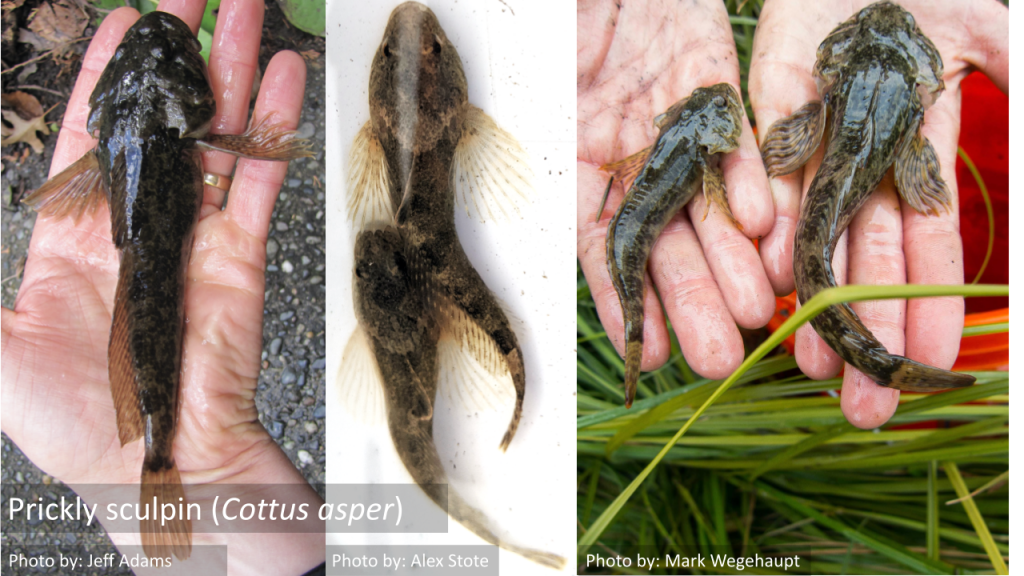
Prickly sculpin (Cottus asper, COAS) from a Washington lake and Washington’s Pacific coast. A typically freshwater fish, they make forays into estuaries to take advantage of abundant prey and habitat. Photos courtesy of Alex Stote, Mark Wegehaupt and Jeff Adams
Crab Team has now observed enough COAS, OLMA and LEAR over the years that we can begin to explore the Crab Team data set for patterns. We can explore how fish abundance has changed from month to month each year. At a quick glance, it’s interesting to see that staghorn come to our traps much more in the spring than later in the summer, and while we don’t have nearly as much data on prickly and tidepool, they appear to show up in Crab Team traps more early and late in the season. Maybe if you’re a small sculpin, you don’t want to be hanging around when the staghorns are on the move? So much to explore with all the amazing data Crab Teamers have collected over the years and continue to build upon!

Comparison of Crab Team counts for all sites by year for staghorn (LEAR), prickly (COAS) and tidepool (OLMA) sculpin from 2016-2020. (Click to enlarge figure)
Honorable Mentions
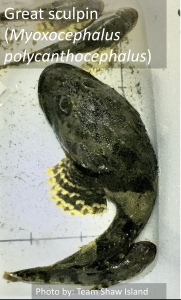
The huge headed great sculpin (Myoxocephalus polyacanthocephalus, MYPO). Photo courtesy of the Shaw Island Crab Team.
And to round out the bullheads, we have a couple honorable mentions. In 2020, volunteers lugged a single great sculpin (Myoxocephalus polycanthocephalus, MYPO … that scientific name looks like something one would attempt to say while waving a magic wand!) up from one of their Fukui traps at the Crab Team site on Shaw Island. The name “great” isn’t hyperbole, this species is one of the biggies, growing to 2.5’ (yes that’s two and a half feet!) in length and over 20 pounds, second only to the largest sculpin in our region – cabazon, which can exceed three feet in length. Great sculpins sport a truly huge, almost prehistoric-looking head, and enormous mouth. The head is so large their body seems like somewhat of an afterthought. They also have really long (kinda scary) preopercular spines.
And Crab Team’s newest addition is the padded sculpin (Artedius fenestralis, ARFE). It’s another small sculpin with a handful of close relatives and a slew of similar small sculpin species. While this was the first year we observed it in traps, padded sculpin showed up at two sites, one on Vashon and one on Bainbridge Island. Though it has similarities to both tidepool and staghorn sculpins, one feature that’s really noticeable is the padded sculpin has a very rough head. Not that we give all fish noogies, but after rubbing the heads of lots of staghorns to get them to stick out their spines for identification purposes (the “sculping popping” technique), this feature actually becomes really handy. The opercular spines of padded sculpins are forked but without as many branches and far shorter than staghorn, making them somewhat similar to the tidepool in that respect. ARFE’s nose isn’t quite as pinched as a tidepool and it’s less big and broad than staghorn or prickly, and quite upturned when viewed from the side. You can also see fine rows of scales on either side of the dorsal fin, which is different from a lot of sculpins who are relatively scaleless. On the artsy side, the splotchy patterns on the sides of their belly? So cool! A good reminder that sculpins can be strikingly beautiful and that some can also quickly strike a pose, changing color to better match their environment.
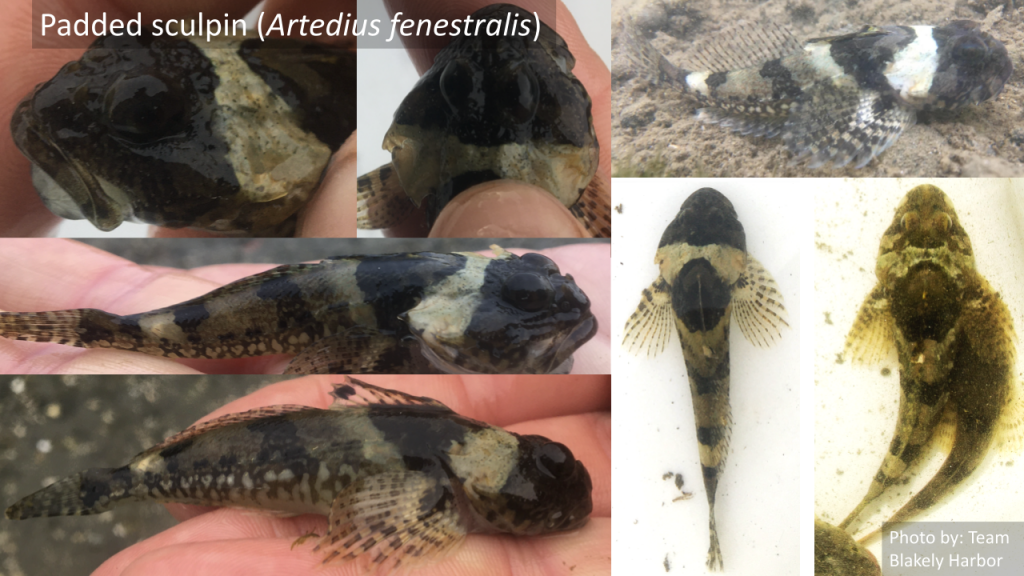
Two different examples and different angles of padded sculpin (Artedius fenestralis, ARFE). Photos courtesy of the Blakely Harbor Crab Team and Jeff Adams.
Can’t Get Enough Sculpin?
Of course the web is full of info on the region’s sculpin species, and they appear in a lot of marine life books. It seems like comprehensive and comprehensible sculpin info is a little harder to find though. A couple fairly comprehensive resources are on the top of our list. For really great images and info at an unbeatable price, you can download Greg Jensen’s Pacific Northwest Sculpins ebook at molamarine.com. Ted Pietsch and James Orr’s Fishes of the Salish Sea: Puget Sound and the Straits of Georgia and Juan de Fuca is comprehensive, in-depth and beautiful. It even includes the prickly sculpin (COAS) which seems to be frequently left off marine guides. It’s a pricey three-book set but might be great for a holiday present or for perusing at the library. You can also hone your own search image of “the big three” (LEAR, COAS, OLMA), in our set of sculpin flashcards. Maybe during the 2022 field season we’ll have a new oddball bullhead or two, and some casual cottid visits from those in this article. Since Crab Teamers are so good at taking lots of pictures of uncertain creatures, we all look forward to further honing our search images and sharing more of the Salish Sea’s sculpin diversity.
– Jeff Adams
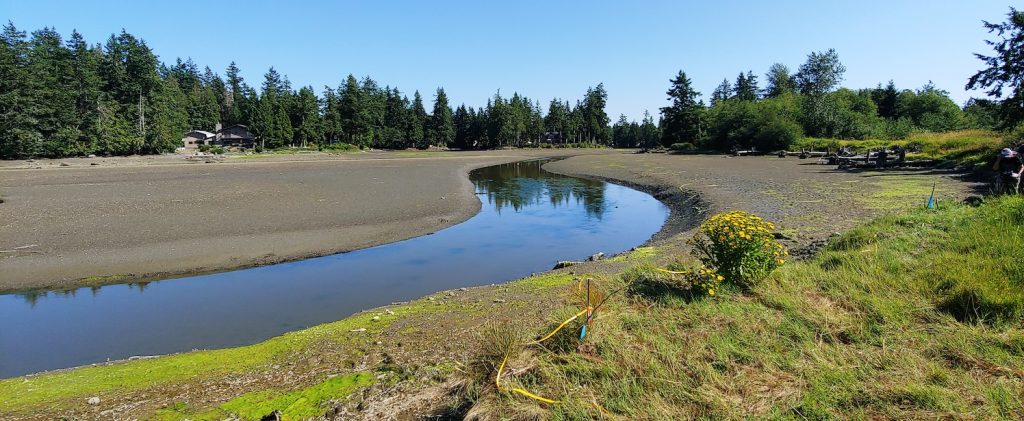 On August 22, 2019, Margaret Santamaria and Margarette Grant were scanning a beach in Drayton Harbor during a COASST marine debris survey and noticed an unusual shell on the shoreline. Because they are also Crab Team volunteers, they immediately knew which crab this molt came from—the invasive European green crab. Since this detection, collaborative management efforts have been launched to remove as many green crabs as possible. To date more than 7,000 traps have been set in Drayton Harbor alone, capturing more than 400 crabs in the last two years. You might say that detection was, “the crab that launched a thousand traps,” but the story of Crab Team in Drayton Harbor actually starts several years before green crabs were ever detected there, and offers a perfect miniature of how volunteer monitoring is at the core of efforts to protect the Salish Sea.
On August 22, 2019, Margaret Santamaria and Margarette Grant were scanning a beach in Drayton Harbor during a COASST marine debris survey and noticed an unusual shell on the shoreline. Because they are also Crab Team volunteers, they immediately knew which crab this molt came from—the invasive European green crab. Since this detection, collaborative management efforts have been launched to remove as many green crabs as possible. To date more than 7,000 traps have been set in Drayton Harbor alone, capturing more than 400 crabs in the last two years. You might say that detection was, “the crab that launched a thousand traps,” but the story of Crab Team in Drayton Harbor actually starts several years before green crabs were ever detected there, and offers a perfect miniature of how volunteer monitoring is at the core of efforts to protect the Salish Sea.
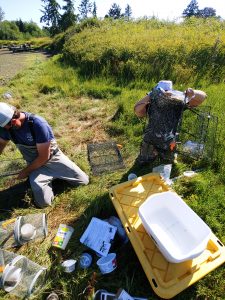
Drayton Harbor Crab Team volunteers (Rob D. and Margaret S.) wrangle traps and crabs during monthly monitoring at Crab Team site at the mouth of California Creek. Photo courtesy of Rondi Nordal.
Site Start-up
The monthly Crab Team monitoring site at Drayton Harbor was originally established at the mouth of California Creek in 2017, where volunteers and staff at a partner organization, RE Sources, have continued to set six monthly traps, from April through September for the past five years. From the beginning, Drayton Harbor had an important role to play in the Crab Team network, as the northernmost monitoring site and literally within sight of the Canadian border. Making this site work has not been without challenges, but for every challenge, the right people have seemed to pop up at just the right time to meet it. First, the location of the site at California Creek is on private property, and it is never a given that we can reach someone to request permission, let alone that they will be OK with having folks on their property. Surprisingly, the owners at that time not only responded to our letter, and gave Crab Team the go-ahead to monitor, but they also drove across the border from their home in Canada to give staff a personal site tour! Since then, Whatcom Land Trust and then Blaine-Birch Bay Parks and Recreation acquired the land and have continued to allow monitoring access as the activities are consistent with their desire to have a protected natural environment.
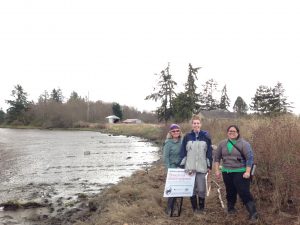
Original Crab Team volunteers at Drayton Harbor in 2017- Barbara Craig, Carrie Craig and Vanessa Guerra (left to right).
The second challenge with this location involves the topography of the site. Both the muddy bottom and limiting tides can be quite tricky to navigate. In fact, Crab Team wasn’t entirely sure the mud was doable at all – that is until Vanessa Guerra and Carrie Craig came along and offered to dive in. As two of the original volunteers at this site, Guerra had already gotten her hands on European green crab through her volunteer work in San Francisco, so she knew she was getting into. Both Craig and Guerra have strong backgrounds in biology and had moved to the area so that Guerra could continue her Ph.D. studies in biology at Simon Fraser University in British Columbia. They have expressed a deep professional and personal appreciation for estuaries and salt marshes, because as Craig said, they are “some of the most productive and vital habitats for wildlife.” Craig already had deep roots in the area, having grown up a few miles from Drayton Harbor and even recruited her mother, Barbara, to participate in monitoring. In reflecting on their experience with monitoring, Craig noted that they, “were excited to have the opportunity to monitor a site that didn’t seem to have green crabs yet, and hoped to be part of the safety net of early detection and monitoring.” This original team has since moved on to continue careers in biology and marine science, but Craig hopes that through the efforts of Crab Team volunteers and partners, “the biodiversity of the waters of Washington State can be protected.”
Monitoring Continues
A lot has changed at Drayton Harbor since this original trio conducted monthly monitoring, but the monthly Crab Team sampling protocols have continued just as before. Volunteers and partners have carried the torch through the years, maintaining a consistent record of all species caught in traps, habitat observations and molts collected. You might wonder, if the early detection function of the site has already been accomplished, why do we keep trapping? The Crab Team network and protocols were designed to collect data continuously, starting before and after the arrival of green crabs, to capture “baseline” data over several years, and then continuing afterward to track any changes in green crab numbers and native species that might occur if green crabs become abundant. Of course we hope they never do.
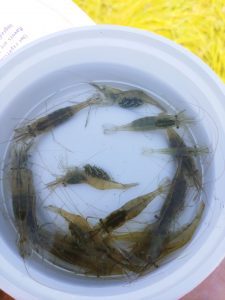
Non-native shrimp Palaemon macrodactylus captured in Crab Team trap during monthly monitoring. Photo courtesy of Rondi Nordal.
So, even as managers spend the trapping season criss crossing all of Drayton Harbor with traps, Crab Team volunteers set their three minnow and Fukui traps at the mouth of California Creek each month, just as they have since 2017. Santamaria, one of the eagle-eyed volunteers who spotted the original molt, said that she continues to contribute to these efforts because she is, “concerned about the impact green crab could have on native species.” Since the first detections in 2019, the Drayton Harbor monitoring team has captured two green crabs during Crab Team sampling, both during 2020, and everyone is relieved those numbers have stayed very low! This site has had other surprises for us though, in recent years, volunteers uncovered another non-native species in Drayton Harbor—Palaemon macrodactylus (or PAMA for Crab Teamers). Originally mistaken as broken back shrimp, this species had slipped under the Crab Team radar in part because its presence along Washington’s shorelines wasn’t well documented. This discovery is yet another example of how valuable consistent scientific monitoring can be in tracking larger ecosystem changes.
Critical Collaboration
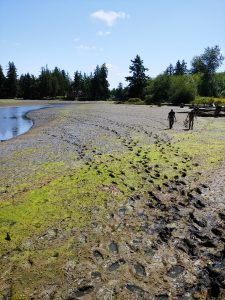
Sticky, muddy terrain makes setting traps challenging at Drayton Harbor, for volunteers and staff alike! Pictured here are Crab Team volunteers Cameron S. and Rob D. Photo courtesy of Rondi Nordal
In addition to Crab Team volunteers monitoring at this site, RE Sources staff have helped recruit many confident mud walkers from their North Sound Stewards community science program and coordinate logistics for Crab Team monitoring in Drayton Harbor. Their local leadership has made continuous monitoring at this site possible, especially considering the challenges involved in navigating the very sticky mud. Lead scientist Eleanor Hines has coordinated monthly monitoring efforts at the California Creek Crab Team site since 2018, and in 2021, a new AmeriCorps member Rondi Nordal stepped into this role. Reflecting on her experience, Nordal noted that “Crab Team addresses such an important issue. Being part of a program that’s that impactful is really cool, especially at a site that we see [European green crabs].” Nordal also highlights the important role volunteers play in this work, because, “we don’t have enough staff scientists to do this work without volunteers.” With 55 Crab Team monitoring sites across the Puget Sound, we couldn’t agree more! Volunteers truly are the heart of this work, making it possible to keep tabs on a much wider geography than would be possible by staff alone.
Right Place, Right Time, Right Team
Drayton Harbor is a great example of how citizen science monitoring networks can support management efforts to find invasive species early, not only through the trapping capacity, but through the human capacity. We call monitors like Santamaria and Grant “Super Volunteers,” not just because they are fantastic, but also because they are cross-trained in multiple ecological projects, in this case Crab Team and COASST. They made the detection while doing monitoring for COASST, but they were only able to do so because they had training about green crab identification. Crab Team is lucky to have a lot of Super Volunteers in the mud with us who also work with programs like SoundToxins, Salish Sea Stewards, Kitsap Beach Naturalists, and the list goes on. By learning about “their beach” from several angles, Super Volunteers develop a really deep level of shoreline knowledge, are able to draw connections across the multiple domains they work in, and get engaged with the agencies that can help. In doing so, they become better able to advocate for the protection of their home beaches. It’s truly impressive to see the impact volunteers can make when they dive into their back yard lagoons!
Since volunteers sounded the alarm in 2019, the story that has continued is a perfect demonstration of the power of collaborative rapid response and management. The rapid assessments and collaborative removal efforts (Read More: Part 1, Part 2) that have been conducted since that time have drawn on multiple agencies and helped managers develop efficient removal techniques that can be used at other sites. While Crab Team monitoring is consistent, removal trapping is adaptive and managers used what was observed in 2020 to strengthen trapping strategies in 2021. Already this strategy of adaptive management is showing promise and early findings suggest that trapping has effectively decreased the green crab population in Drayton. As this year’s field season comes to a close, we look forward to digging more into what lessons were learned through a second year of targeted removal trapping at this unique site in the Salish Sea. Stay tuned!
–Amy B. Linhart
Photo Gallery
We love to get the virtual experience of monitoring with all of the Crab Team volunteers. Do you have a photo to share? Send it to crabteam@uw.edu. (Click on arrows to scroll, and photos to enlarge for more detail.)
